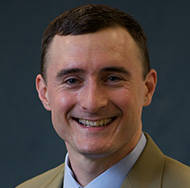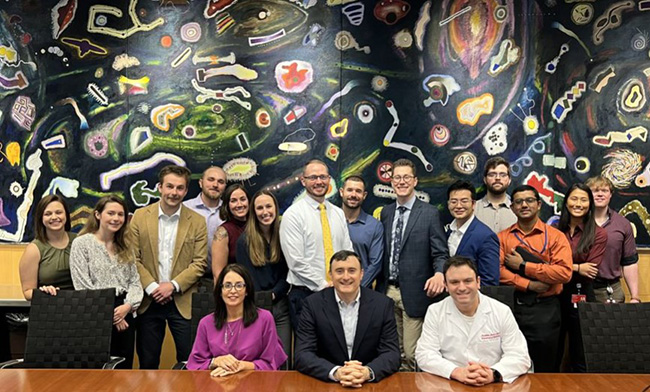Henderson M. Jones, MD, JD, and Hanna K. Thompson (medical student, University of Louisville)
Early Medical Student Exposure to Research, Trauma and Radiology
 At the University of Louisville, residents and medical students are working on a unique research project to boost the profile of radiology among medical students and give medical students exposure to research and trauma cases. In a nutshell, medical students are provided data from the hospital trauma registry, including a list of patients with a particular injury to study — specifically, the radiological features of the injury.
At the University of Louisville, residents and medical students are working on a unique research project to boost the profile of radiology among medical students and give medical students exposure to research and trauma cases. In a nutshell, medical students are provided data from the hospital trauma registry, including a list of patients with a particular injury to study — specifically, the radiological features of the injury.
The project was conceived in the fall of 2021 by resident, Henderson M. Jones, MD, JD, and emergency radiology attending, Jonathan K. Joshi, MD, as they worked together reading out a "man scan" (CT chest/ abdomen/ pelvis with contrast) of a patient shot twice. That patient had critical injuries and would soon be taken to the operating room for an exploratory laparotomy.
After completing the study, Drs. Jones and Joshi resolved to study the alarming trend of gunshot wounds (GSWs) in Louisville and to understand more about the injuries. “During my time in medical school, I had set a goal of conducting a large-scale chart review project involving medical students,” Jones says. He also added that he had already participated in two such projects himself.
The first stage of the project was to meet with Trauma Surgeon Keith R. Miller, MD, to obtain permission to access 10 years of GSW data from the trauma registry maintained by the University of Louisville Hospital Trauma Institute. A trauma registry is required by the American College of Surgeons for the accreditation of Level I and Level II trauma centers.
Jones credits the interest and assistance of senior medical student, Rebecca L. Guan, with initiation of the project in January 2022. “A research project takes planning and good timing,” comments Jones, who had to complete the Institutional Review Board (IRB) process and obtain data from the trauma registry, right around the time of the CORE exam.
After completing the CORE exam, Jones and Guan called a meeting of all interested medical students to join the “GSW Project,” as it was called. The response went beyond their expectations — 16 medical students participated, wanting to join the project. Guan was joined by Nicholas W. Kemper, also a senior medical student.
Guan and Kemper coordinated the other medical students' acquisition of datasets, electronic medical record chart review, and the search and analysis of images in PACS. The group used guidelines from the American Association for the Surgery of Trauma Injury Scoring Scale to characterize and understand various injuries. Jones remarks, “The secondary objective of this project is for some medical students to have the opportunity to take charge and lead the group, and Guan and Kemper were those student leaders.”
The University of Louisville scientific showcase event, Research!Louisville, held during the week of Sept. 19 –23, 2022, was “ our day in the sun,” says Jones. “Our project produced 13 of the 96 medical student posters at the showcase,” he continued. “We had a great sense of comradery and accomplishment because we had all worked together as a team.”

Radiology Research Group at Research!Louisville, September 2022.
At a team meeting after the poster presentations, the students reflected on what worked well and decided to expand the project to study motor vehicle collision (MVC) injuries from the trauma registry and to produce a larger showing of posters, addressing even more complicated research questions for Research!Louisville 2023. Students were encouraged to submit their work to national radiology conferences and other relevant conferences.
Following Research!Louisville 2022, student surveys on qualitative outcomes reported high satisfaction with their experiences, gaining skills in science writing, giving effective oral presentations, and analyzing data from spreadsheets and electronic medical records. Most felt prepared to pursue more demanding research projects. All students indicated this project increased their career path clarification and 16 students showed a greater understanding of radiology research.
The GSW Project had diverse appeal, with seven students interested in radiology residency, five listed as undecided and five showing interest in anesthesia, emergency medicine, internal medicine, pediatrics or family medicine. “I think this experience was very valuable and unique. Working with other students was one of the best parts of this research experience,” says Guan.
Other GSW studies include a poster on cervical vascular injuries, presented virtually in October 2022 at the 3rd Annual International Medical Student Radiology Symposium, sponsored by the University of Arizona College of Medicine in Phoenix. In November 2022, three posters, including a new poster on esophageal injury due to GSW, were presented at the annual meeting of the Kentucky chapter of the American College of Emergency Physicians.
In March 2023, first-year medical student Alex Myers presented an oral presentation on the case series of GSW cardiac injuries at the Society of Thoracic Radiology Annual Meeting. In April 2023, the poster on bladder and urethral injuries due to GSW was presented virtually at American Roentgen Ray Society Annual Meeting.
Jones is proud that some GSW projects had enough academic rigor that they were accepted for presentation at other regional and national conferences, but he is most proud that the project is being continued and expanded to include MVCs.
“I am passing the resident leadership role to a medical student Hanna Thompson and my co-residents, Tatiana Mamaliga, MD, Amir Sheth, MD, and Teja Suryadevara, MD,” he commented. “Thompson and four other medical students who completed projects and are now eager to lead a new group of medical students into the new “GSW-MVC Project.”
A second IRB has already been approved to pull 10 years of MVC patient data from the trauma registry, and the existing GSW data is now inspiring additional potential projects.
The students plan to increase collaboration with other medical students interested in trauma surgery and surgery subspecialties that deal with GSW and MVC trauma injuries. They also plan to present 30 posters for a local research showcase in September. To encourage even more involvement, the group is also approaching the medical school to present their project to matriculating medical students during orientation.
In February 2023, Jones presented a poster for his abstract entitled, Blueprint for Early Medical Student Exposure to Research, Trauma, and Radiology: Trauma Registry Gunshot Wound Projects, at the ACGME Annual Conference in Nashville. In April 2023, Jones presented a similar poster at the Association of University Radiologists Annual Conference in Austin.
Most medical students only receive exposure to radiology if they choose to complete a clinical elective in their third or fourth year. This unique project helps close the gap in medical student exposure to radiology. It is interesting to ponder the impact that this project will have on the participating students during medical school and beyond.